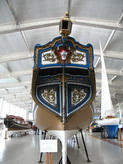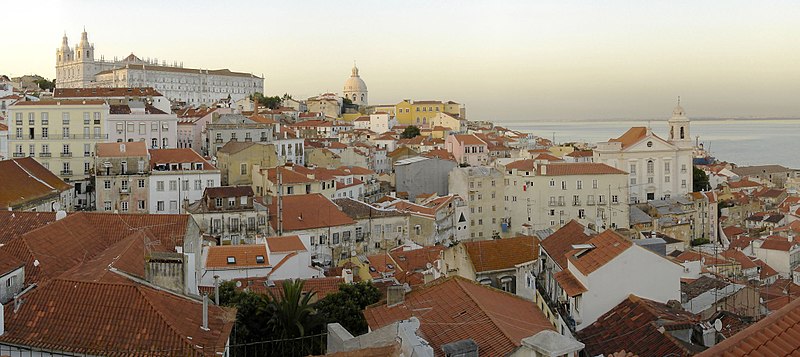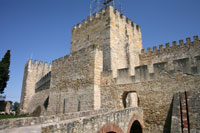"We wander for distraction, but we travel for fulfillment."
Hilaire Belloc
"Without new experiences, something inside of us sleeps. The sleeper must awaken.”
Frank Herbert
 |
| Tram in Lisbon |
As Portugal's capital city, Lisbon holds a concentration of historical and cultural attractions and is the nation's most cosmopolitan city. Lisbon is a charming mix of now and then. Old wooden trolleys travel up and down the hills, there are cobbled streets and bird-stained statues, and Art Nouveau cafes to relax and have a cup of coffee. There are parks, and squares, and old world architecture. Lisbon is one of the few European capitals with both a river and a coastline, the city spreads along the north bank of the River Tagus and meets the ocean.
 |
| Lisbon |
We have plans to go to Lisbon in 2014. I have never been there before, although we were close to the border when we were in Spain in 2001. We will not be on a tour, so I am starting to look into where in Portugal we plan to go, and what there is to see. I'm sure our first stop will be in Lisbon, so that is where I am starting. We plan to explore other areas of Portugal, including the Algarve area, which is where we will most certainly spend at least a week. But Lisbon will be our starting point.
So what is there to see and do in Lisbon? Like most European cities, just walking around the historic area of the city will be a joy. The cities in Europe are so different from our cities, with so much history and culture to see. And for those of us into photography, it is a joy to point our cameras at all the old architecture. Lisbon will certainly have lots of things for us to see.
My first purchase in Lisbon will most likely be a Lisboa card, which is a Lisbon City Pass and is a great way for tourists, like myself, to save money when seeing the local attractions.

Once purchased, the card offers free or discounted entrance to more than 80
Lisbon museums, sights, and tours, including the Jeronimos Monastery, the Belem Tower and the National Pantheon. It also gives you free transportation around the city, because the Lisboa Card includes all trips on the Metro, public buses, trams and the
Elevadores. It even covers some sights outside the city, to some of the nearby cities. The card costs approximately 18 Euros for adults, and 11 Euros for children.
Lisbon is made up of 7 hills, and at the top of each hill an amazing view awaits. While the hills can be steep for climbing, there are many funiculars and trams connecting them. the Lisboa Card will come in handy in getting you around the city.
There are three main districts that you should definitely visit while in Lisbon. They are the Alfama, Bairro Alto and Belem. I will probably start my sightseeing in the Belem area of Lisbon, which is where the Age of Discovery began. Ships commanded by the likes of Vasco da Gama and Henry the Navigator set their sails here returning with tales of adventure, bloodshed, and riches. Discovering a sea route to India, Gama helped aide in Portugal's rise to one of the world's greatest empires. Belem is where two of the most popular tourists sights are - The Belem Tower and the Mosteiro dos Jeronimos.
 |
| Pastel del Belem- a custard pastry famous in Lisbon |
Belem is also where you can purchase a Portugese taste treat known as Pastel del Belem. These are cream tarts that are famous throughout Portugal, but were first created in 1837 in Lisbon. The best place to buy these are where they originated in a shop called Casa Pasties de Belem. Enjoy one with a sprinkling of cinnamon and powdered sugar, with a cup of coffee, or whatever you enjoy to drink. It is a good way to start off your sightseeing day in the Belem area of Lisbon.
 |
| Belem Tower |
Belem Tower is probably the most famous of the local sights. In Portuguse, it is Torre de Belem or the Tower of St. Vincent. It is a fortified tower located in the mouth of the Tagus River and is the gateway to Lisbon. The Tower has been named a UNESCO World Heritage Site, The tower was commissioned by King John II and was built in 1515 to guard the harbor of Lisbon.
The tower is open 10AM - 5PM (Oct.- Apr) and 10AM - 6:30PM (May - Sept.). It is closed on Mondays. It cost 5 Euros to enter, or with the Lisboa Card it is free.
 |
| The Monastery |
The Mosteiro dos Jeronimos (Monastery of Jeronimos) is just a short walk away from the tower. Its intricate decorations and peaceful spaces will leave you inspired. It was built in the 16th century and is considered one of Lisbon's most magnificent buildings. Here you will go inside the church to view the architecture, and visit the tombs. You can also visit the cloisters and there is a garden to walk through. The monastery is also a UNESCO World Heritage Site.
 |
| Inside the Museu da Marinha |
Museu Da Marinha (Maritime Museum) is near both the tower and the monastery. This is the place to go if you want to understand how Portugal rose to become one of the greatest maritime and trading powers in the world. The museum houses maps, documents, navigational instruments and models of ships from the era of discoveries through to this century.
Palacio da Ajuda is also in Belem. Just above the pink National Palace (the official residence of the President of Portugal which is not open to the public), is the former Ajuda royal palace, built between 1796 and 1826. It was occupied by the royal family and remained the royal residence until the abolition of the monarchy in 1910. It is sumptuously furnished with tapestries, sculptures, oriental carpets and historic paintings. There is a display of the royal jewelry, crystal and other treasures. It is still used for state occasions.
 |
View of Alfama district
taken from the Miradouro de Santa Catarina |
The Alfama district is the most famous part of town, which is a labyrinth of alleys, miniature squares and whitewashed houses rising in tiers from the Tagus River. This is quite a contrast with the area below Alfama. The low-lying district closer to the river is the Baixa district which was totally destroyed by an earthquake in 1765 and was rebuilt with a precise grid form with magnificent squares and alleys. But the Alfama district, with its winding cobbled streets and alleys, is best explored on foot during the mid-morning market time or in the early evening with the streets teem with locals. Exploring the streets and alleyways is a good way to get a feel for Lisbon's Moorish past. A climb through the Alfama district to the castle on top is rewarded by stupendous views over the Tagus and its suspension bridge.
 |
| Tower of Ulysses in Castle Sao Jorge |
The Castle of São Jorge is a Moorish castle occupying a commanding hilltop overlooking the historic area of Lisbon. Saint George's Castle can be seen from almost everywhere in the city. Its oldest parts date from the 6th century. It is now an oasis of peace, but just past the main gate is a statue of King Afonso Henriques and a series of cannons, reminders of the castle's original purpose. What remains of the Alcaçovas Palace where medieval kings lived, is a stone building now housing a restaurant, and round the back, a small archaeological museum in three underground chambers (including the one where Vasco da Gama was once received by King Manuel).
Most of the castle was destroyed over the years, especially in the Great Earthquake, but still includes a long extension of walls and 18 towers. Visitors can climb the towers and walk along the ramparts for the best views of the city, or relax in the gardens where peacocks, geese and ducks strut around. One of the castle's inner towers, the Tower of Ulysses, holds the Câmara Escura, a periscope that projects sights from around the city.
 |
| Bairro Alto |
The Bairro Alto district also attracts visitors. This is the bohemian quarter of the city, rising to the west in steep streets and stone staircases and lined with restaurants and bars. This is a good place to head for an evening meal. The area can seem sketchy, but it's as safe as the rest of the city. The area is a favorite among locals. The lower part of this district is the elegant Chiado with fashionable department stores and tea houses. You can catch a lift from there up the hill.
 |
| Miradouro de Santa Catarina |
The Miradouro de Santa Catarina is a place you should visit for more great views of the city Next door to the Bairro Alto is the neighborhood of Santa Catarina. This area has streets of pastel-painted houses but very few restaruants and bars. It is mostly known for its garden with a terrace offering river views. Within this terrace you will find a stone figure of Adamastor, a mythical sea monster from the poem "The Lusiads." There is also a pleasant café where locals go to admire the dawn view over the Tagus. You will also have a great view of the 25th of April Bridge over the Tagus, which is one of the longest suspension bridges in the world.
If you would like to take a tour of the city or a day tour to some areas near Lisbon there are lots of companies available. But the one that I would book if I was doing a tour is with a company called "We Hate Tourism Tours". They seem to do more individual type tours, and not the usual things that anyone can see. From the reviews I read online from people who had taken the tour, it was more like being shown the area by a good friend who lived there. Not the typical big bus experience for sure.
 |
When you wander the back streets of a city
you see how people live and get a feel for
the city. |
There are certainly many more things and areas to see around Lisbon. Like anyplace you visit you need to just get a feel for the place, and to do that you should wander around by foot, as much as possible, and sample the food, do some people-watching and just soak up the sights and sounds of the city. You should visit the local flea markets or open markets when you see them. There is even a Thieves Market, which is in the area of Igreja de Sao Vincente de Fora. Here you can browse through all sorts of interesting things to purchase. There are also some pretty good antique shops and stalls that you will find while exploring. Just walking around exploring a new city is my favorite part of traveling.
**pictures taken from the internet


 Once purchased, the card offers free or discounted entrance to more than 80 Lisbon museums, sights, and tours, including the Jeronimos Monastery, the Belem Tower and the National Pantheon. It also gives you free transportation around the city, because the Lisboa Card includes all trips on the Metro, public buses, trams and the Elevadores. It even covers some sights outside the city, to some of the nearby cities. The card costs approximately 18 Euros for adults, and 11 Euros for children.
Once purchased, the card offers free or discounted entrance to more than 80 Lisbon museums, sights, and tours, including the Jeronimos Monastery, the Belem Tower and the National Pantheon. It also gives you free transportation around the city, because the Lisboa Card includes all trips on the Metro, public buses, trams and the Elevadores. It even covers some sights outside the city, to some of the nearby cities. The card costs approximately 18 Euros for adults, and 11 Euros for children.








No comments:
Post a Comment